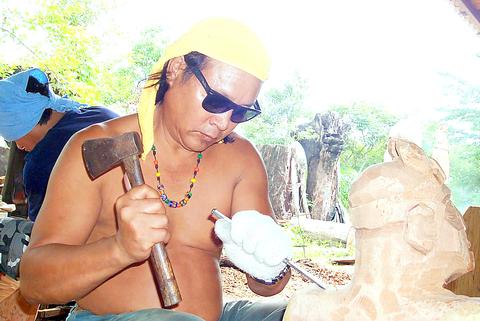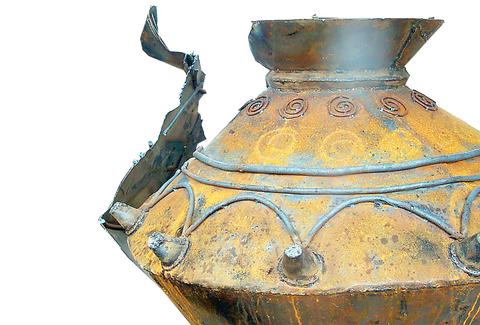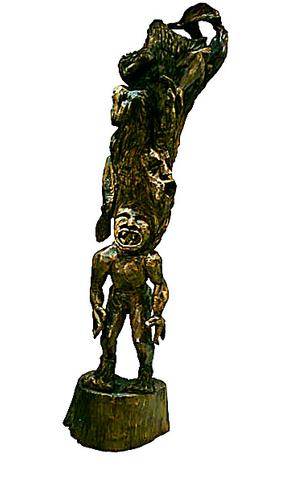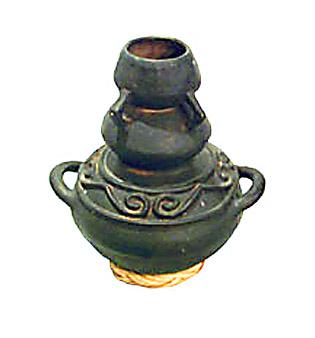The furniture is a mixture of cheap wooden benches and massive chairs hewn from single chunks of wood. A fire burns in an overturned oil barrel that has been cut in half. Millet wine is ladled from a jar into paper cups using a segment of bamboo. Siki (希巨.蘇飛), a sculptor from Taiwan's Amis Aborigines, his broad features and long hair highlighted by the fire, sings a sorrowful tune in a bold baritone.
The gathering in the compound of the Taiwan Aboriginal Modern Art Center (台灣原住民當代藝術中心) in Taitung (台東) followed a day of visits to the studios of local artists by a group of media and visiting arts and craft workers from around Taiwan. The Aborigine artists, widely dispersed and only just beginning to organize, had come together to discuss the role of Aborigine art in Taiwan and Aborigines' tenuous control over their works in an art world dominated by Han Chinese culture and the tourism industry.

PHOTO: COURTESY OF THE BUNNUN CULTURAL FOUNDATION
Some argued over the difficulty of making a living from their work, while others feared that compromise with the commercial art market endangered their unique cultural heritage.

PHOTO: COURTESY OF THE BUNNUN CULTURAL FOUNDATION
The Taiwan Aboriginal Modern Art Center, established by the Bunnun Cultural Foundation (布農文化基金會), seeks to combine the roles of a community center for local artists, a distribution center for their art and a resort hotel to bring visitors to the area and allow them to gain familiarity with Aboriginal art. The center's multiple functions seem to embody the tensions between creativity and the commercial imperative over which the artists wrangled at the three-day meeting.
As a place to gather and talk, Siki said the center had value, but primarily he drew inspiration from the festivals and stories told by the old men of his tribe. An independent spirit, he has little time for overtly commercial considerations.

PHOTO: COURTESY OF THE BUNNUN CULTURAL FOUNDATION
An undefined threat

PHOTO: COURTESY OF THE BUNNUN CULTURAL FOUNDATION
For Lahatze (季.拉黑子) -- a highly successful Amis Aboriginal sculptor, singer and poet -- the threat to Aboriginal art lies in the undermining of Aborigines' self-esteem and commitment to their art. "We cannot allow the government or scholars to tell us what it is to be Aboriginal, or what constitutes being Amis," he said in an impassioned plea to fellow artists, asking that they "take a stand."
"We aren't insistent enough over our own standards," Lahatze said. "We are afraid."
Speaking in reference to government subsidies for Aboriginal art -- and much money has been spent, though its beneficiaries are rarely Aborigines -- Lahatze said: "If you are really working for your culture and your people, then the question of subsidies does not really come into the issue." In the bright light of the Taitung sun, this seemed a hopelessly romantic notion for a people whose culture is threatened by the overwhelming tide of modern Chinese culture.
Lahatze, however, has a reputation and recognition that allow him to speak in such bold terms. Other artists rarely have such freedom. "We have to eat," was a phrase often repeated among the artists. For most, succumbing to market forces is an inevitable hurdle to reaching a larger market.
The commercial imperative
A Paiwan potter known by his nickname Ah Liang (
Some artists are less burdened by cultural purism and are more than happy to provide what the market seeks.
Artists such as E-Dai (王信一) freely admitted that his sculptures served market demand. And working out of a local resort hotel, E-Dai has plenty of opportunity to interact with visitors.
"When hotels look for sculptures for decoration or for sale, they review the work of many artists," he said. "The features of my figures are softer and more acceptable. This is why I have lots of orders."
E-Dai's proudly pragmatic approach to marketing and selling his work seems in response to an art market that has typically overlooked or flatly ignored Aboriginal art.
Cheng Hui-mei (鄭惠美) of the Taipei Fine Arts Museum (TFAM), commenting on the absence of Aboriginal art from TFAM and other major display venues, said that "compared to the work of Australian Aboriginal artists [in a mixed exhibition held at TFAM three years ago, Taiwan Aboriginal art] looked very inferior."
Many Aboriginal artists agree with this assessment, and say the sad state of Aboriginal art is symptomatic of the destitution, alcoholism, unemployment and depression that have wrecked havoc on Aborigine culture.
Wang Hung-yu (王鴻佑), chief editor of New Idea magazine (新觀念), concurs that a basic lack of self-confidence lies at the heart of Aboriginal art's inability to win recognition among mainstream collectors. He said that in contrast to Taiwan, Aboriginal art in Australia was co-opted as Australia's national art, despite an Anglo-Saxon ethnic majority.
"Aboriginal art has real potential," Wang said, "and it is probably better that with their limited resources, Aboriginal artists aim directly at the international market." Wang suggested that Taiwanese have a "cultural cringe" which makes them wary of endorsing anything that hasn't the imprimatur of foreign approval. "When [Aboriginal art] receives acclaim abroad, then it will be respected here," he said.
Ironically, the artists most willing to experiment with modern ideas tend to hold themselves the highest aesthetic and cultural standards of Aboriginal art. At Siki's workshop on the Taitung coastal highway, sculptures 1m high tell stories of spirits and demons of Amis legend. The presentation is semi-abstract, drawing "on the legends of my people," and have a great deal more appeal than the crudely-executed and cliche pieces of Aboriginal art that litter most hotels in the area.
Sakuliu Pavavalung (撒.古流), probably the best-known of Taiwan's Aboriginal artists, also spoke of the need to reconcile tradition and modern culture. He envisioned a cultural evolution, incorporating new ideas to prevent culture from becoming moribund. "I live in the present, so I do the things of a modern man," he said, discussing modern zoomorphic architectural designs that couple modern materials with Aboriginal totemic motifs. For Sakuliu, creating san object of beauty is the only way to transcend the boundaries that separate Aboriginal art from mainstream art in Taiwan. The question that remains unasked, is whether it then ceases to be Aboriginal art.
TFAM's Cheng was more cautious in endorsing the future prospects for Aboriginal art. She said: "We should not use the standards of modern art to judge Aboriginal art. Aboriginal art has its own potential, but it should be judged in its own terms," suggesting mainstream and fringe arts can coexist.
But while the experts analyze, Aboriginal artists around Taiwan fret over the limited opportunities on offer. Government support for Aboriginal art has a patchy record, and high-profile events such as the monumental wood carving event held in Taipei's Ta-an Park last November, have been dismissed by many, including Lahatze, as nothing more than a trivalization of Aboriginal cultural heritage. "These are just cultural 'activities' and have nothing to do with artistic endeavor."
While most hope that the government would show greater sensitivity, or that arts venues would offer exhibition space to Aboriginal artwork, the ultimate challenge, as everyone around the camp fire recognized, lay with the artists themselves, and how they balance economic advancement with artistic and cultural integrity.

On April 26, The Lancet published a letter from two doctors at Taichung-based China Medical University Hospital (CMUH) warning that “Taiwan’s Health Care System is on the Brink of Collapse.” The authors said that “Years of policy inaction and mismanagement of resources have led to the National Health Insurance system operating under unsustainable conditions.” The pushback was immediate. Errors in the paper were quickly identified and publicized, to discredit the authors (the hospital apologized). CNA reported that CMUH said the letter described Taiwan in 2021 as having 62 nurses per 10,000 people, when the correct number was 78 nurses per 10,000

As we live longer, our risk of cognitive impairment is increasing. How can we delay the onset of symptoms? Do we have to give up every indulgence or can small changes make a difference? We asked neurologists for tips on how to keep our brains healthy for life. TAKE CARE OF YOUR HEALTH “All of the sensible things that apply to bodily health apply to brain health,” says Suzanne O’Sullivan, a consultant in neurology at the National Hospital for Neurology and Neurosurgery in London, and the author of The Age of Diagnosis. “When you’re 20, you can get away with absolute

May 5 to May 11 What started out as friction between Taiwanese students at Taichung First High School and a Japanese head cook escalated dramatically over the first two weeks of May 1927. It began on April 30 when the cook’s wife knew that lotus starch used in that night’s dinner had rat feces in it, but failed to inform staff until the meal was already prepared. The students believed that her silence was intentional, and filed a complaint. The school’s Japanese administrators sided with the cook’s family, dismissing the students as troublemakers and clamping down on their freedoms — with

As Donald Trump’s executive order in March led to the shuttering of Voice of America (VOA) — the global broadcaster whose roots date back to the fight against Nazi propaganda — he quickly attracted support from figures not used to aligning themselves with any US administration. Trump had ordered the US Agency for Global Media, the federal agency that funds VOA and other groups promoting independent journalism overseas, to be “eliminated to the maximum extent consistent with applicable law.” The decision suddenly halted programming in 49 languages to more than 425 million people. In Moscow, Margarita Simonyan, the hardline editor-in-chief of the